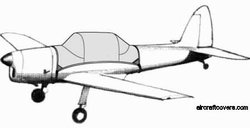Sat, May 17, 2014
Some Exhibit Cracks In Fittings Attaching Horizontal Stab To Fuselage
The FAA has issued a Special Airworthiness Information Bulletin (SAIB) addressing cracking discovered in certain aluminum fittings that attach the horizontal stabilizer to the fuselage of Robert E. Rust, Jr. Models DeHavilland DH.C1 Chipmunk 21; DH.C1 Chipmunk 22A; DH.C1 Chipmunk 22; serial numbers C1-001 through C1-1014 airplanes.

The FAA says that the Chipmunk 22A airplanes may also be identified by other model numbers such as CHIPMUNK; CHIPMUNK 22A; CHIPMUNK DH22; CHIPMUNK DHC-1T10; CHIPMUNK T10; CHIPMUNK T.10 MK-22; DHC-1; DHC-1A CHIPMUNK; DHC-1B-2; DHC-1B-2-S3; DHC-1B-2-S5; DHC-1C; DHC-1 CHIPMUNK ; DHC1 CHIPMUNK 21; DHC-1 CHIPMUNK 22; DHC1 CHIPMUNK 22A ; DHC-1 SERIES 22; DHC-1 SERIES 23; DHC-1 T.MK. 10; DHC-1 CHIPMUNKX ; DH.C1 MK22A; CHIPMUNK; CHIPMUNK; CHIPMUNK MK20; DHC-1 CHIPMUNK ; DEHAVILLAND DHC-1.
The SAIB also addresses shims that may be incorrectly installed between the subject fittings and their mating components.
According to the SAIB, the FAA recently became aware of an airworthiness concern through an airworthiness directive (AD) issued by the United Kingdom Civil Aviation Authority Airworthiness (U.K. CAA). This AD, G-2013-0002, dated October 2, 2013, concerns the fittings that attach the horizontal stabilizer (tailplane) to the fuselage and includes the following:
- Cracking has been discovered in an early build standard of tailplane attachment fitting (potential quantity four per aircraft). The fitting is manufactured from aluminum alloy forging and the failure mode is still under investigation. Modification action dating back to the earliest years of the Chipmunk’s service replaced this affected fitting with a similar item made from steel. These modifications were not mandated and it is now necessary to ensure the integrity of those aluminum alloy fittings which remain in service. However, the number of alloy fittings remaining in service is likely to be minimal in the UK, but potentially significant overseas.
- As part of its evaluation of the cracked bracket, DHSL has also identified the potential for misassembly of the fittings, leading to an inadvertent but small change of tailplane incidence. This situation might have some effect on the aircraft flight characteristics.
- DHSL have therefore issued Technical News Sheet (TNS) CT(C1) No 209, Issue 1, dated 01 September 2013, which requires a check for correct assembly of the fittings and introduces a repeat crack test of aluminum tailplane attachment fittings.
The FAA recommends the following for de Havilland DH.C1 Chipmunk 21, 22, and 22A airplanes, serial numbers C1-001 through C1-1014, with standard or experimental airworthiness certificates:
- Inspect for damaged fittings and incorrect shim (packer) installation at the next 100-hour or annual inspection, whichever occurs first.
- Replace any damaged fittings and correct any shim installation if required before further flight.Repeat the inspections of aluminum fittings at each 100-hour or annual inspection, whichever occurs first, or modify the airplane with steel fittings, as noted in and in accordance with de Havilland Support Limited; Technical News Sheet Series CT(C1) No. 209, Issue 1-Tailplane Attachment Fittings-Cracking and Misassembly.
More News
Decision Altitude (DA) A specified altitude (mean sea level (MSL)) on an instrument approach procedure (ILS, GLS, vertically guided RNAV) at which the pilot must decide whether to >[...]
Aero Linx: T-34 Association, Inc. The T-34 Association was formed in July 1975 so that individuals purchasing then military surplus T-34As had an organization which would provide s>[...]
As He Released The Brakes To Begin Taxiing, The Brake Pedals Went To The Floor With No Braking Action Analysis: The pilot reported that during engine start up, he applied the brake>[...]
“Legislation like the Mental Health in Aviation Act is still imperative to hold the FAA accountable for the changes they clearly acknowledge need to be made... We cannot wait>[...]
Also: IAE Acquires Diamond Trainers, Army Drones, FedEx Pilots Warning, DA62 MPP To Dresden Tech Uni The danger to the flight training industry and our future pilots is clear. Dona>[...]
 ANN's Daily Aero-Term (12.08.25): Decision Altitude (DA)
ANN's Daily Aero-Term (12.08.25): Decision Altitude (DA) ANN's Daily Aero-Linx (12.08.25)
ANN's Daily Aero-Linx (12.08.25) NTSB Final Report: Piper PA-31T3
NTSB Final Report: Piper PA-31T3 Aero-News: Quote of the Day (12.08.25)
Aero-News: Quote of the Day (12.08.25) Airborne-Flight Training 12.04.25: Ldg Fee Danger, Av Mental Health, PC-7 MKX
Airborne-Flight Training 12.04.25: Ldg Fee Danger, Av Mental Health, PC-7 MKX



